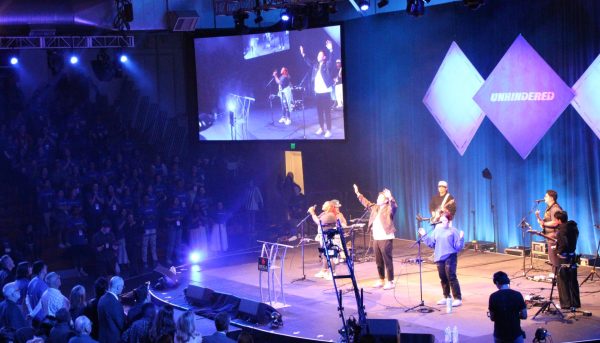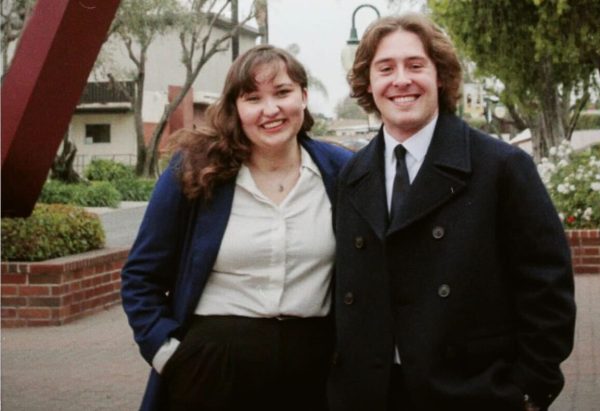Shaking out the kinks: Campus Safety runs a campus-wide earthquake drill
What would happen to Biola if “the big one” hit? Last week a team of Biola staff got a peek. Campus Safety, along with administrators all around campus, responded Thursday to a mock catastrophic earthquake that inflicted heavy damage and many injuries on Biola’s campus.
John Ojeisekhoba, deputy chief, gives his officers assignments in preparation for the campus-wide Great Southern California ShakeOut, the nation’s largest earthquake drill. Photo by Bethany Cissel
November 17, 2008
What would happen to Biola if “the big one” hit? Last week a team of Biola staff got a peek.
Campus Safety, along with administrators all around campus, responded Thursday to a mock catastrophic earthquake that inflicted heavy damage and many injuries on Biola’s campus.
The event was part of The Great Southern California ShakeOut, the nation’s largest earthquake drill, which more than 5 million people participated in this year, according to the drill’s Web site. The drill setup a scenario in which a 7.8 magnitude earthquake occurred along the southern portion of the San Andreas Fault, near the Saltan Sea.
Campus Safety set up an “emergency operations center” in Lot C near the tennis courts in anticipation of the drill, which began with the “earthquake” striking at 10 a.m. Designated “Emergency Response Team” members from departments across campus met at the location to be briefed on the situation.
From there, a mass role-playing exercise ensued.
Radio reports were broadcasted to the team from Campus Safety officers stationed around campus, informing them of damages that had occurred. Emerson Hall had collapsed, there was a gas leak in the Caf and students were trapped in the on-campus apartments’ elevators. Numerous students had also been injured by falling debris, or by jumping out of their dorm.
E.R.T. members interacted in real time with the information being radioed in, telling officers how they wanted to respond to each incident. For example, when injuries were reported, Kristin Phelps, Health Center representative, directed the dispatched Campus Safety officers by radio on how to care for the victims.
Similarly, when it was determined by Facilities Services representatives that none of the buildings were safe to be in, Don Sims, of housing and food services, had to determine where to keep stranded students and what to feed them.
The scenario proved frustrating for Ken Bascom, who was responsible for surveying damage. After finding out that the gas leak in the Caf had turned into a fire, and that the business building had collapsed, he threw up his arms.
“This scenario is just not realistic, I’m sorry,” he said to John Ojeisekhoba, deputy chief of Campus Safety.
Jerry Powell, chief of Campus Safety, acknowledged to the E.R.T. after the drill the difficulty of the scenario, but said the best way to be prepared is to prepare for the worst.
“In a disaster, everything that can go wrong tends to go wrong,” he said. “The overwhelmingness of it is to bring you together.”
Carissa Brooks, Biola’s manager of emergency operations and disaster preparedness, said the frustration invoked among the E.R.T. was a good sign that the drill was realistic and effective.
“Our goal this year was get people to feel like they could be confident in what their role was but to make the situation as realistic as possible,” Brooks said. “So when you invoke emotions it shows that, yeah, this is a real situation and that this is something that can affect us really deeply.”
The drill exposed a need for additional means of communication, Brooks said. Internet and all telephone connections were disrupted in the scenario, leading many in the E.R.T. to question how they would be able to communicate with anyone outside of the campus.
In addition, the 3N system Campus Safety used to send out campus-wide messages was abnormally slow. Many businesses and agencies in the region also used 3N during the drill, causing the system to be “completely overwhelmed,” Brooks said.
Brooks said she is researching satellite telephones, which she hopes to have by next year. She said the phones cost around $1,500 each, not including usage costs, but it’s “either that or nothing.”
During the drill Biola interacted with the City of La Mirada, which was also participating. Campus Safety reported the campus’s status to the fire department early in the drill, though a fire truck did not arrive till about an hour and a half later. Apparently the city had to deal with a “major catastrophe” at the La Mirada Theatre, which occurred in its scenario, Brooks said.
This year’s ShakeOut scenario was developed by over 300 scientists and engineers led by Dr. Lucy Jones, a U.S. Geological Survey seismologist, according to the ShakeOut media guide. Individuals, businesses, government offices, and schools across Southern California participated in the drill to varying degrees. Some simply conducted “duck and cover” drills at 10 a.m. when the mock earthquake struck and shook for two minutes.







